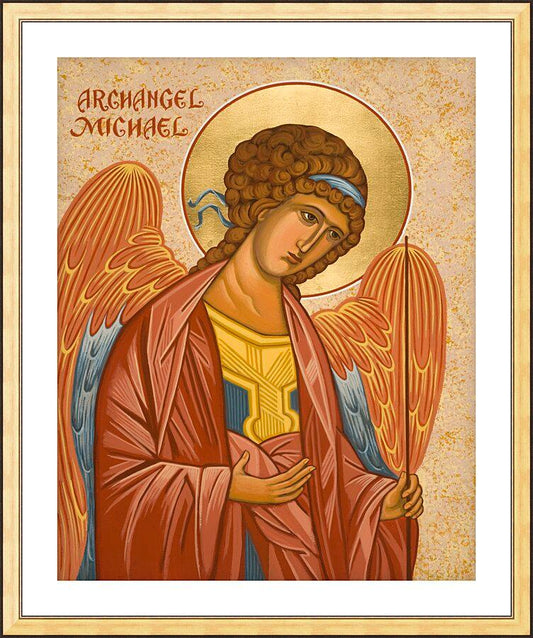Collection: St. Michael Archangel

-
Sale
Wood Plaque Premium
Regular price From $99.95 USDRegular priceUnit price per$111.06 USDSale price From $99.95 USDSale -
Sale
Wood Plaque
Regular price From $34.95 USDRegular priceUnit price per$38.83 USDSale price From $34.95 USDSale -
Sale
Wall Frame Espresso
Regular price From $109.95 USDRegular priceUnit price per$122.17 USDSale price From $109.95 USDSale -
Sale
Wall Frame Gold
Regular price From $109.95 USDRegular priceUnit price per$122.17 USDSale price From $109.95 USDSale -
Sale
Wall Frame Black
Regular price From $109.95 USDRegular priceUnit price per$122.17 USDSale price From $109.95 USDSale -
Sale
Canvas Print
Regular price From $84.95 USDRegular priceUnit price per$94.39 USDSale price From $84.95 USDSale -
Sale
Metal Print
Regular price From $94.95 USDRegular priceUnit price per$105.50 USDSale price From $94.95 USDSale -
Sale
Acrylic Print
Regular price From $94.95 USDRegular priceUnit price per$105.50 USDSale price From $94.95 USDSale -
Sale
Giclée Print
Regular price From $19.95 USDRegular priceUnit price per$22.17 USDSale price From $19.95 USDSale -
Custom Text Note Card
Regular price From $300.00 USDRegular priceUnit price per$333.33 USDSale price From $300.00 USDSale
ARTIST: Joan Cole
ARTWORK NARRATIVE:
God, the Father of our Lord Jesus Christ, we call upon Thy holy name, and we humbly implore Thy clemency, that by the intercession of Mary, ever Virgin Immaculate and our Mother, and of the glorious Archangel St. Michael, Thou wouldst deign to help us against Satan and all other unclean spirits, who wander about the world for the injury of the human race and the ruin of souls. Amen.
His feast day is September 29.
- Art Collection:
-
Saints And Angels
- Patronage:
-
Watermen,
-
Temptations,
-
Storms,
-
Soldiers,
-
Sickness,
-
Security Guards,
-
Security Forces,
-
Sailors,
-
Radiologists,
-
Puebla Mexico,
-
Police,
-
Paratroopers,
-
Paramedics,
-
Mariners,
-
Knights,
-
Holy Death,
-
Hat Makers,
-
Grocers,
-
Germany,
-
Fencing,
-
EMTs,
-
Dying,
-
Danger at Sea,
-
Boatmen,
-
Battle,
-
Bakers,
-
Artists,
-
Ambulance Drivers
In the early 6th century when Gobnait fled her home in County Clare, she went to Inis OÃrr. We don't know why she fled, only that she believed she would find refuge in the Aran Islands. Legend states that an angel appeared to her there and told her that her place was not on Inis OÃrr, and instructed Gobnait to go on a journey — to seek her true place of resurrection. “Go until you find nine white deer grazing" the angel told her. “It is there that you will find your place of resurrection." So Gobnait wandered about the southern coastal counties of Ireland — Waterford, Cork and Kerry — searching.
She saw three white deer in Clondrohid and followed them to Ballymakeera where she saw six more. But it wasn't until she came to Ballyvourney to a small rise overlooking the River Sullane that she saw the nine white deer all together - grazing ... just as the angel from Inis OÃrr had prophesied. She crossed the river and settled there. She founded a religious community for women, performed memorable — some say miraculous works, and it was there she died and was buried.
February 11th is St. Gobnait's feast day -the day her memorable life is celebrated. She is one of the few Irish saints that is not only remembered in her native region, but has been proclaimed by the Irish bishops to be a national saint. There are shrines and places of devotion to St. Gobnait in all the places she is believed to have stopped on her journey - including Inis OÃrr. But Ballyvourney, where she carried out most of her ministry, is the place that draws the greatest number of pilgrims devoted to this saint.
Today there is an active church on the former monastic site. St. Gobnait's grave and marked spots around the churchyard are places where pilgrims pause for devotion and reflection. It is here that they can do the “rounds" or turas, always moving in a clockwise direction — a tradition that has pagan roots. One of the strongest mystical draws on this site is St. Gobnait's Holy Well, with its arched entryway that takes the pilgrim into a deeply shaded path. Just next to the well is a sturdy tree, and hanging from it are hundreds of tokens or “clooties" that have been placed there by pilgrims hoping to leave behind a part of themselves or loved on in need of healing. There are taps and cups available for drinking from the well or for pouring into personal vessels to take holy well water home.
St. Gobnait was best known for her care of the sick. There is a legend that tells of her staving off the plague from Ballyvourney by drawing a line in sand with a stick and declaring the village “consecrated ground." Inside the church today, there is a medieval (possibly 13th century) figure of St. Gobnait which is kept in a drawer. Every year on her feast day, the parish priest brings out the figure to celebrate a devotional tradition. He holds up the ancient figure and the faithful each step forward with a piece of ribbon. They hold the ribbon up and measure it against the length and around the circumference of the figure, then take it home as a blessed relic used for healing or further devotion.
A tall statue of St. Gobnait that was erected in the 1950s stands near the monastic site. She appears with a nun's habit standing on a bee hive surrounded by bees. Gobnait is the patron saint of bee keepers, and there are several legends recalling Gobnait forcing invaders out of Ballyvourney by setting swarms of bees upon them. It's probable that Gobnait had a close relationship with bees and used honey in healing efforts.
Additional Items Our Customers Like
-
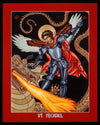
St. Michael Archangel (by Lewis Williams, OFS)
-
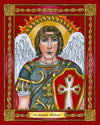
St. Michael Archangel (by Brenda Nippert)
-
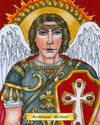
St. Michael Archangel (by Brenda Nippert)
-
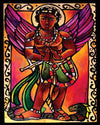
St. Michael Archangel (by Br. Mickey McGrath, OSFS)
-

St. Michael Archangel: Patron of Police and First Responders (by Br. Mickey McGrath, OSFS)
-
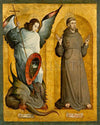
Sts. Michael Archangel and Francis of Assisi (by Museum Religious Art Classics)




